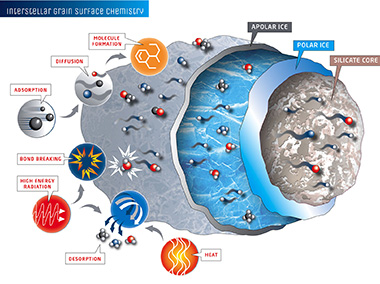Interstellar Grain Surface Chemistry

Star- and planet-forming regions are rich in many different small and large molecules, such as water and ethanol (alcohol). One of the primary locations where these molecules form, are the surfaces of minuscule interstellar ice-covered dust grains. These dust grains are smaller than a micrometer, yet are very efficient chemical factories. In the ice covering these grains, many atoms and molecules are closely packed together, allowing them to easily react and form new, more complex molecules.
Through laboratory experiments, theoretical simulations, and telescope observations, astronomers now have a good general understanding of these grains. As the grains cool down, atoms and molecules adsorb (freeze-out) on their surfaces and form the icy mantles. Such an icy mantle is layered and consists of a water-dominated layer (polar) and a water-poor layer (apolar). Molecules and atoms can diffuse (move around) and in this way find partners to react with, forming more complex species. This process is aided by different kinds of energetic radiation, such as ultraviolet radiation, that impinges on the grains. Heat, for example from a star, and radiation are able to desorb (release) these molecules from the grain surfaces into the gas phase. The molecules that form on interstellar dust grains can be trapped in comets and may even end up on planets and in their atmospheres. Therefore, interstellar chemistry on dust grains may be of astrobiological significance for planets by providing their initial molecular inventory, and leaving them with all the necessary ingredients to form life.